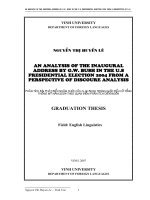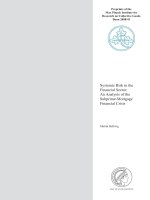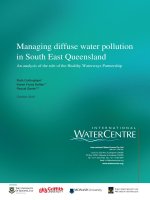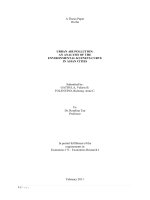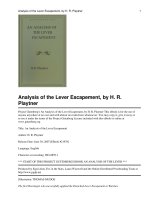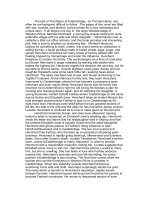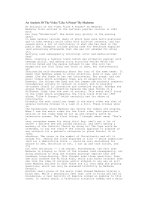COMET AND ASTEROID RISK: AN ANALYSIS OF THE 1908 TUNGUSKA EVENT pdf
Bạn đang xem bản rút gọn của tài liệu. Xem và tải ngay bản đầy đủ của tài liệu tại đây (1.26 MB, 17 trang )
COMET AND ASTEROID RISK: AN
ANALYSIS OF THE 1908
TUNGUSKA EVENT
RMS Special Report
© 2009 Risk Management Solutions, Inc. 1
INTRODUCTION
Early in the morning on June 30, 1908, a giant airburst occurred over the basin of the Podkamennaya Tunguska
River in Central Siberia, Russia, leveling trees over an area of 2,000 km
2
(770 mi
2
) (Figure 1). Eyewitnesses
described a ―fire ball, bright as the Sun‖ (Longo, 2007). The event produced seismic and pressure waves that
were recorded all over the world and led to atmospheric phenomena (e.g., bright nights, noctilucent clouds)
observed over much of Eurasia. The released energy was later estimated to be equivalent to a 10 megaton
(Mton) TNT explosion, about 1,000 times as powerful as the nuclear bomb dropped over Hiroshima in 1945.
Although the origin of this phenomenon has been widely debated for the past century, it is now generally
accepted that the blast was due to the explosion of a comet or an asteroid in the lower atmosphere, occurring
at a height of 5 to 10 km (3 to 6 mi) over the remote Siberian forest, and measuring approximately 50 m (164
ft) in diameter (Longo, 2007 and
Figure 1: Felled trees in the Tunguska impact area in Russia following an explosion of an asteroid
or a comet in the atmosphere on June 30, 1908; about 80 million trees were leveled by the blast
(Source: Soviet Academy of Science 1927 expedition led by Leonid Kulik)
Due to the remote impact location, this disaster did not cause any significant damage to human settlements.
However, the occurrence of a Tunguska-type event over a populated region would constitute a major
catastrophe. This report begins with a discussion of the risk associated with extraterrestrial bodies orbiting the
sun, including comets and asteroids, which can become meteors and meteorites, hitting the Earth’s atmosphere
and surface, respectively. Examples of small and moderate-sized impact events in recent history are detailed. A
Tunguska-type footprint is also developed, based on the available information from felled trees and inferences
from blast impacts, to estimate the property and casualty impacts of a similar-sized event over the Manhattan
Borough of New York City. Finally, the implications of comet and asteroid risk for the insurance industry are
highlighted, including the recurrence probability of these types of events.
© 2009 Risk Management Solutions, Inc. 2
COMET AND ASTEROID RISK
When considering how to quantify the risks associated with asteroids or comets impacting the Earth’s
atmosphere and surface, the rarity of these very destructive events means that the threat is generally
discounted. However, the 1908 Tunguska airburst reminds us that the threat is real. To understand this threat,
it is useful to consider different categories of risk, depending on the size of the asteroid or comet as it enters
the atmosphere and collides with the Earth’s surface.
Massive (~ 1 km in diameter or larger)
A massive object colliding with the Earth’s surface would have direct impacts on a continental scale, as well as
global consequences with social, economic, and political implications. These events are extremely rare, with
examples observed at geological timescales. For example, a massive asteroid led to the demise of dinosaurs 65
million years ago. Implications of major impacts are so extreme that the principles of insurability are not met,
such as the pricing of the risk. As a result, managing massive asteroid and comet impacts are far beyond the
scope of the insurance system. However, some work has been done to investigate mitigation and policy
frameworks linked to major impacts (i.e., global destruction with inconceivable odds) (see Urias et al., 1996
and Sommer, 2005).
Medium (~ 10s-100s m in diameter)
An object up to 100s of meters in diameter impacting the Earth is also rare in human history. With the
exception of the 1908 Tunguska event, there is no clear evidence of similar impacts in the past few centuries.
The impact from such an event would be concentrated (affecting an area 10s to 100s of kilometers in diameter)
but consequences could range from local to regional depending on where the collision occurs. For example, the
1908 Tunguska event led to very few casualties and no property losses because it occurred in a remote region
of Siberia. A reproduction of this event over a highly populated region could lead to hundreds of thousands of
casualties and hundreds of billions dollars of damage. It would also cause losses beyond the capacity of the
insurance market. However, as long as a major city is not impacted, the consequences would be comparable to
the impacts of a major earthquake. In this case, insurance companies would likely remain viable, even though
premiums were not collected nor reinsurance purchased against an event of this size.
Small (~10 m in diameter or smaller)
The occurrence of small objects entering the Earth’s atmosphere is frequent, with impacts on the surface
several times per year. When the initial comet or asteroid is only a few meters in diameter, it is highly
influenced by its journey through the Earth’s atmosphere. It generally fragments along its luminescent path
(commonly termed a ―shooting star‖) and if the original mass is not completely lost by ablation, the remaining
fragments hit the ground (i.e., become meteorites). In most cases, minimal energy is left at impact but on rare
occasions, the impact produces a crater measuring a few meters to tens of meters large. In this case, resulting
damage and insured loss depends on the location of the crater. For example, if a small meteorite were to strike
a group of buildings, a small subset of the insurance industry would be affected by the impact. This itself is a
highly improbable event; the chance of a small meteorite causing massive devastation by hitting something as
potentially destructive as a nuclear power plant is even more remote.
Recent Small Meteorite Impact Events
There are numerous examples of small meteorite strikes over populated areas in recent history. In 2003, a
meteorite shower occurred over the Chicago suburb of Park Forest, Illinois. While many stones fell, they only
caused minor damage, including damage to roofs, windows, and car windshields. In some cases, stones broke
through ceilings and damaged building contents. A map of the impact area and a picture of ceiling damage in
the Park Forest event is shown in Figure 2, along with pictures of damage in two other recent examples of
meteorite falls—the 2007 Cali, Colombia event (Figure 2(b)) and the 2008 Zunhua, China event (Figure 2(c)).
The low levels of damage reflect the small size of the meteorites—a few kilograms at best—and the dissipation
of their orbital velocities, as they simply fell from the sky. Although there is no definitive record of human
casualties due to meteorite strikes, hundreds of claims have been made (Lewis, 1996). For example, in the 20
th
© 2009 Risk Management Solutions, Inc. 3
century, a meteorite injured a woman in 1954 (in Sylacauga, Alabama) and another meteorite killed a cow in
1972 (in Valera, Venezuela).
Figure 2: Impacts of small meteorite events over urban areas, with map showing the 2003 Park
Forest, Illinois, meteorite field (left), redrawn from Simon et al., 2004 and examples of roof and
ceiling damage caused by meteorites (right): (a) 2003 Park Forest, Illinois damage (Source: R.
Elliott); (b) 2007 Cali, Columbia damage (Source: M. Farmer) and (c) 2008 Zunhua, China
damage (Source: M. Farmer)
As previously indicated, contrary to the majority of objects that lose their initial energy by fragmenting in the
atmosphere, on rare occasions, meteorites keep a large fraction of their kinetic energy and strike the Earth,
creating large craters. For example, the 1947 Sikhote-Alin, Russia, event was the largest bolide (meteoritic
fireball) ever witnessed in historical records (Figure 3(a)), impacting an elliptic area of approximately 1 km
2
(0.4 mi
2
) in a remote region of Russia. More than 100 craters were found in the strewn field, with the largest
crater measuring 28 m (92 ft) in diameter and 6 m (20 ft) deep (Gallant, 1996). Tons of meteoritic iron
shrapnel were also found in the area. More recently, in 2007, a fireball appeared in the sky over Bolivia and
Peru and remained intact while it traveled through the atmosphere, keeping a significant proportion of its pre-
atmospheric speed (Brown et al., 2008). The impact caused the formation of a crater 13 m (43 ft) in diameter,
very close to the small Peruvian village of Carancas (Figure 3(b)).
© 2009 Risk Management Solutions, Inc. 4
Figure 3: Crater-forming impacts of small meteorite events: (a) painting representing the 1947
Sikhote-Alin, Russia event by artist P. J. Medvedev and (b) the crater of the 2007 Carancas, Peru
event, measuring 13 m in diameter (Source: M. Farmer)
Had these two events occurred in more populated regions, they would have certainly caused severe damage
and led to many casualties. In this way, the damage caused by crater-forming meteorite strikes can be
compared to wartime or terrorist bombing attacks—but with no target, striking at random across the Earth’s
surface.
Evidence of Medium (Tunguska-type) Events
Larger objects measuring 10s to 100s of meters in diameter, such as the object that exploded in the 1908
Tunguska event, are far less common. Moreover, there is no clear evidence of similar-sized objects exploding
over the Earth in recorded human history. This does not mean, however, that no similar-sized events have
occurred. The Tunguska event would likely have been missed or forgotten had no one gone to the Siberian
forest to study the phenomenon. One century after the impact, the evidence has been mostly erased by the re-
growth of vegetation. Moreover, had the strike occurred over the ocean, as is the case for approximately 70%
of such events given the planet’s land-ocean distribution, any trace of the impact would only be found on the
ocean floor. As stated by Bailie (2007), this type of impact is a great ―invisible hazard.‖
Objects of similar size to the Tunguska event can create a large crater upon impact if they do not explode and
fragment in the atmosphere. For example, Meteor Crater in Winslow, Arizona (Figure 4) is an approximately
1,200-m (3938-ft) diameter crater created by the impact of a 50-m (164-ft) diameter iron meteorite 49,000
years ago. Based on the rarity of having a cosmic body composed of solid iron, crater-forming events are
expected to be a lot less frequent than airburst events. Indeed, iron meteorites, which are less likely to explode
in the atmosphere than rocks, represent only 5% of meteorite falls. This means that the majority of Tunguska-
class events would leave no scar on the Earth’s surface.
There is also a high probability that other impact craters would have been obliterated by erosion (note that
Meteor Crater is subject to very low erosion rates) or remained unidentified until now (e.g., on the ocean floor,
in dense forests, or camouflaged as circular lakes). As for recent craters identified as such, they are generally
poorly dated and therefore difficult to relate to any past catastrophe.
© 2009 Risk Management Solutions, Inc. 5
Figure 4: Example of medium-sized meteorite impacts: Meteor Crater in Winslow, Arizona,
measuring 1,200 m in diameter and occurring 49,000 years ago. (Source: United States
Geological Survey)
The lack of evidence of Tunguska-type impacts in the historical or archeological record is arguably related to
the fact that catastrophes of unknown origin have been linked to other hazards that are more frequent and
better understood, such as major volcanic eruptions or earthquakes. The Holocene Impact Working Group
(HIWG), formed in 2005, conducted a study to test this hypothesis. The results of the study indicate that
impacts may have affected the movement of recent agricultural populations, collapsed past civilizations and
even caused the Dark Ages (see review in Baillie, 2007). Some evidence can be obtained from tsunami deposits
(Blakeslee, 2006), tree-ring and ice records, astronomical observations, and even myths
1
. One of the goals of
the HIWG is to demonstrate that impacts have been more frequent in the recent past than currently believed.
For example, impacts may have led to the end of the Clovis culture at 13,000 BCE, the Great Flood at
approximately 5000 BCE (Carney, 2007), the ―years without summers‖ at 535–545 CE, and the Little Ice Age at
1450 CE. (For more information, see
1
For more information about geomythology or the referencing of geological events in mythology, see Piccardi and Masse (2007).
© 2009 Risk Management Solutions, Inc. 6
MODELING THE IMPACTS OF A REPEAT OF THE 1908 TUNGUSKA
AIRBURST
Damage Inference from Felled Trees
In order to model the effects of the 1908 Tunguska event, a damage footprint that estimates the geographic
scope and magnitude of impacts must be developed. The challenge in doing so, however, is the lack of data
from which damage inferences can be made. What really happened on June 30, 1908, in the middle of the
Siberian forest still remains a mystery, particularly because no fragment of the cosmic body has ever been
found. Further, no impact crater has been identified, although this last point has recently been challenged in
the literature (Gasperini et al., 2007). It is only from sparse eyewitness accounts and the data on forest
devastation that the footprint of this disaster can be estimated. Figure 5 shows two proposed footprints for the
1908 event based on a study of felled trees. The footprint in Figure 5(a) (Longo et al., 2005) provides the most
accurate contour of the blast to date. The footprint in Figure 5(b) (Serra et al., 1994) offers additional
information by distinguishing regions where fallen trees were partially burned (dark grey) from regions where
they were only pushed down (light gray). In both illustrations, fallen trees form a radial pattern, which
indicates the source of the blast (shown as a red dot in Figure 5(a) and a black dot in Figure 5(b)).
Figure 5: Damage footprint of the 1908 Tunguska airburst determined from the study of felled
trees: (a) map of the blast impact from Longo et al. (2005), where the azimuths of felled trees
converge to the focal point of the blast (red dot). The color range from white to dark blue
indicates an increase in azimuth measures’ reliability (Source: http://www-
th.bo.infn.it/tunguska/); (b) damage footprint from Serra et al. (1994), indicating the limit of
overthrown trees (solid line) and the limit of charred trees (dashed line). The black dot indicates
the focal point of the blast.
From these tree footprints, two types of damage are observed. First, trees were leveled over an area covering
approximately 2,000 km
2
(770 mi
2
) (Figure 5(a)) and large fires were ignited near ground zero (Figure 5(b)).
Although these felled trees give an indication about the size, the directivity, and the intensity of the Tunguska
blast, converting this information into a damage footprint for analysis purposes is not a straightforward matter.
There is no available information about damage attenuation from the source to the limit of the footprint, as
trees have relatively brittle vulnerabilities and are either standing or fallen. The vulnerability of property and
© 2009 Risk Management Solutions, Inc. 7
people to a Tunguska-like blast, as compared to trees, must be determined. Contrary to other hazards, such as
earthquakes and hurricanes, there are no historical events documenting the damage to property and people
that can directly determine vulnerability. Comparisons to other perils must be made.
Comparison to Blast Damage
One solution is to utilize empirical evidence of blast effects from man-made explosions. For example, Figure 6
shows an example of a damage footprint for a 2-ton TNT equivalent explosion. The damage attenuation
pattern, modeled from engineering blast analysis, is consistent with the damage seen in the truck bomb attack
on the British Consulate in Istanbul in 2003, with an estimated yield equivalent to 2 tons of TNT (RMS, 2008).
In this example, total destruction (i.e., 100% MDR or mean damage ratio) was observed within 15 m (50 ft) of
the truck bomb.
Figure 6: Damage footprint for a 2-ton TNT equivalent explosion, illustrating mean damage ratio
(MDR) as function of distance to source (i.e., attenuation) (Source: RMS, 2008)
However, the 1908 Tunguska event released the energy equivalent of 10 megatons (Mton) of TNT. Therefore,
damage patterns seen in nuclear test explosions are more suitable for analysis purposes. Indeed, the 1908
radial pattern formed by leveled trees was replicated during atmospheric nuclear tests in the 1950s and 1960s.
Using overpressure, in pounds per square inch (psi), as a measure of the severity of the blast and thus the
damage, a footprint was developed for a Tunguska-type event. Figure 7 represents the footprint of an airburst
occurring at an altitude of 5 km (3 mi) with a released energy of 10 Mton. Overpressure in psi per distance
range, shown up to 40 km (25 mi) in radius, is determined by using the formulae and graphs from Glasstone
and Dolan (1977). The 1908 Tunguska footprint, shown in Figure 5(b), is overlaid on this blast footprint for
comparison (in dashed/dotted contour lines) with its ―butterfly‖ shape due to the cosmic body’s trajectory
angle. Although the 1908 event footprint forms a butterfly pattern, the generic footprint is assumed to be
circular (i.e., unknown meteor trajectory).
© 2009 Risk Management Solutions, Inc. 8
Figure 7: Footprint of a man-made airburst and of the 1908 Tunguska event. Overpressure in psi
is indicated per distance range from source (solid contour) and computed for a 10-Mton airburst
occurring at a 5 km altitude. The extent of fallen trees (dashed contour) and charred trees
(dotted contour) from the Tunguska event (Serra et al., 1994) are indicated for comparison. The
Tunguska footprint is centered such that the focus point from which the fallen trees radiate (i.e.,
ground zero) is located at the source of the man-made blast.
The potential property damage caused by a given overpressure is measured in terms of a mean damage ratio
(MDR) and an MDR per distance range from the source of the explosion is developed, similar to Figure 6 (i.e.,
approaches used in terrorism modeling). Table 1 describes the expected property damage due to a 10-Mton
TNT equivalent explosion for various levels of overpressure. These results are obtained from nuclear tests,
taking only into account blast effects, as only approximately 50% of total energy released from a nuclear
weapon is due to the blast. In this case, total destruction is expected for an overpressure greater than 20 psi.
When the footprint in Figure 7, in combination with the damage information in Table 1, is superimposed over
an area with built exposure, the losses can be calculated by multiplying the mean damage ratio by the value at
risk.
Table 1. Expected mean damage ratio of building types as a function of overpressure (in psi) (Source: Office of
Technology Assessment, 1979)
Overpressure
(psi)
Damage Description
Mean Damage
Ratio (%)
20+
Reinforced concrete structures
leveled/destroyed
~100
5+
Factories, commercial buildings
and residential structures
severely damaged or destroyed
~70
1+
Residential structures moderately
or severely damaged
~30
© 2009 Risk Management Solutions, Inc. 9
Fatality and injury rates are also defined from the Office of Technology Assessment (1979), for the same values
of overpressure (Table 2). Note that the extent of damage was 50 km (31 mi) away from the source of the
Tunguska airburst and other far field effects from the blast were recorded in eyewitness reports. For example,
from an eyewitness at the Vanavara trading post, located 65 km (40 m) from the explosion: ―…at that moment
I became so hot that I couldn’t bear it, as if my shirt was on fire…‖ (Kulik, 1930).
Table 2. Expected fatalities and injuries (in percentage), as a function of overpressure (in psi) (Source: Office of
Technology Assessment, 1979)
Overpressure
(psi)
Fatalities (%)
Injuries (%)
20+
~98
~2
5+
~50
~40
1+
~2
~35
Scenario: A Tunguska-type Event over New York City
Considering the 1908 Tunguska event, one might ask what the losses would have been if, instead of occurring
over the Siberian forest, the airburst had occurred over one of the most important economic hubs and most
populated cities in the world. The following scenario considers the occurrence of an event with an impact
footprint similar to the one of the 1908 event over New York City. To assess probable maximum loss, the
footprint is centered over the borough of Manhattan, as illustrated on Figure 8. The mean damage ratio, fatality
rate, and injury rate are assumed to be 70%, 50%, and 40% in the inner contour of the footprint and 30%,
2%, and 35% in the outer contour of the footprint, respectively. These values are determined from Figure 7,
where the majority of the inner footprint is located in the 5+ psi range and the majority of the outer footprint is
within the 1+ psi range. In addition, it is appropriate that the part of the inner footprint which extends into the
1+ psi range, corresponds to higher damage ratios, as the ignition and spread of fires will increase losses. It is
worth noting, however, that the spread of fires is assumed constant over t he area to keep the scenario simple.
© 2009 Risk Management Solutions, Inc. 10
Figure 8: An extreme event scenario: reproduction of the 1908 Tunguska event overlaid (in
yellow) over Manhattan, such that losses are maximized
Expected property damage and casualties
Figure 9(a) shows the residential and commercial property at risk in the New York region from this scenario,
developed from the 2008 RMS
®
U.S. Industry Exposure Database (IED). The U.S. IED is a compilation of
insured assets (buildings and contents) for properties at risk from wind and fire perils. Economic values are
derived from the insured values, considering insurance penetration rates throughout the U.S. Using insured
exposure to the perils of wind and fire is appropriate in this case, since the hazard is due to hurricane-force
winds (e.g., maximum wind speed of 502 mph, 163 mph, and 70 mph for an overpressure of 20 psi, 5 psi, and
2 psi, respectively) (Glasstone and Dolan, 1977) and to fire ignitions due to thermal exposure. Total economic
exposure measures $760 billion between the outer and inner contours of the footprint and $1.38 trillion inside
the inner contour. As a result, property losses are estimated at approximately $1.19 trillion.
Figure 9(b) shows the location of the 1908 Tunguska event footprint in the proposed scenario, over the
population at risk, employing the 2005 United States LandScan
TM
dataset for population concentrations
(LandScan
TM
, 2005), which gives census counts on a 30° by 30° latitude/longitude grid. With a population
exposure of 3.61 million people between the inner and outer contours and 6.25 million people inside the inner
contour, approximately 3.2 million fatalities and 3.76 million injuries are expected.
© 2009 Risk Management Solutions, Inc. 11
(a)
(b)
Figure 9: The 1908 Tunguska footprint centered over Manhattan with (a) economic exposure
(building and contents), showing $2.14 trillion inside the outer contour of the footprint and $1.38
trillion inside the inner contour (Source: RMS, 2008b); (b) population exposure of 9.86 million
people inside the outer contour of the footprint and 6.25 million inside the inner contour (Source:
LandScan, 2005)
© 2009 Risk Management Solutions, Inc. 12
INSURANCE IMPLICATIONS
Recurrence probability of Tunguska-type events
A recent study on the recurrence of objects that collide with the Earth, based on a compilation of many data
sets, estimates a mean return period of 1,000 years (range from 400 to 1,800 years) for collisions with objects
similar in size to the 1908 Tunguska event (Brown et al., 2002). This rate of 1,000 years was previously
estimated to be around 200–300 years (Shoemaker, 1983). Since the frequency cannot be assessed from
historical events, Brown et al. (2002) extrapolated it from the rate of bolide detonations obtained from eight
years of satellite records, as well as from a variety of astronomical observations (e.g., the Spacewatch project
at Note that if some of the unknown events that led to major catastrophes
(e.g., the Dark Ages) were proven to be asteroid or comet impacts, rate estimates would need to be revised
upwards, by up to an order of magnitude.
Figure 10 shows the most up-to-date frequency-magnitude relationship for impacts of small to medium size
objects (<100 m in diameter). From this relationship, Brown et al. (2002) determined the Tunguska-type event
return period of 1,000 years. The relationship proposed by Shoemaker (1983) is also shown for comparison
(dashed line in Figure 10). Following the results from Brown et al. (2002), bolides of approximately 10 m (33 ft)
in diameter occur every decade and bolides of one meter in diameter occur roughly ten times per year.
Although small events are frequent, they generally pose no threat. Only a fraction of these events would have
enough high energy left at impact (e.g., the 1947 Sikhote-Alin, Russia event or the 2007 Carancas, Peru event)
to cause localized damage over a populated region.
Figure 10: Frequency–bolide energy (or equivalent diameter) relationships proposed by Brown et
al. (2002) (bold line) and by Shoemaker (1983) (dashed line) for small near-Earth objects (<100
m) colliding with the Earth. Tunguska-type events (~10 Mton TNT equivalent) are nowadays
estimated to occur around once every 1,000 years (400–1,800 years) (Brown et al., 2002), lower
than the 200–300 years return period proposed previously (Shoemaker, 1983).
© 2009 Risk Management Solutions, Inc. 13
Insurability of Tunguska-type events
In order to assess the impacts of a Tunguska-type event on insured exposure at risk, a probabilistic risk model
based on realistic data must be developed. As discussed in detail by Kovacs and Hallak (2007), an assessment
of the costs of asteroid and comet impacts requires many assumptions and the development of any proposed
probabilistic risk model is difficult, given the lack of historical events.
2
While the accuracy of a risk assessment
model is important, so is the importance of understanding the management of the risk. On the insurance side,
comprehensive multi-peril or all-risk insurance policies cover all risks that are not specifically excluded, meaning
that a Tunguska-type event is generally covered by this type of insurance. It is unclear if, on any current
contractual grounds, insurers would exclude damage caused by such a peril. While the modest premiums
appropriate to be charged for the risk would be uniform across land areas (although a tsunami premium may
also need to be added for coastlines) it seems unlikely that insurers would bother to add this charge explicitly
to their pricing models.
At the same time, an insurer should be aware (similar to managing earthquake risk), even at the extremely low
probabilities determined here, that having a portfolio concentrated in single city creates a greater probability of
ruin for an impact than a well-distributed portfolio. Loss statistics for natural disasters demonstrate a dramatic
increase in losses since 1950. This increase is driven by a concentration of population and property in urban
areas, the development of highly exposed coastal and valley regions, and the complexity of modern societies
and technologies (Smolka, 2006). This shows that the risk associated with extreme asteroid and comet events
can only increase through time and that more research to understand these extremely rare events should be
encouraged.
2
For an example of a probabilistic risk model for Tunguska-type airbursts, see Mignan et al., 2009.
© 2009 Risk Management Solutions, Inc. 14
REFERENCES
Baillie, M. (2007). The case for significant numbers of extraterrestrial impacts through the late Holocene.
Journal of
Quaternary Science,
22(2), 101-109.
Blakeslee, S. (2006, November 14). Ancient crash, epic wave.
New York Times
, Science Section.
Brown, P. et al. (2008). Analysis of a crater forming meteorite impact in Peru.
Journal of Geophysical Research Planets
,
113, E09007, doi:10.1029/2008JE003105.
Brown, P. et al. (2002). The flux of small near-Earth objects colliding with the Earth.
Nature,
420, 294-296.
Carney, S. (2007). Did a Comet Cause the Great Flood? The universal human myth may be the first example of disaster
reporting.
Discover Magazine
, November 2007.
Gallant, R. (1996). Sikhote-Alin Revisited.
Meteorite Magazine
, February 1996.
Gasperini, L. et al. (2007). A possible impact crater for the 1908 Tunguska Event.
Terra Nova
, 19, 245-251.
Glasstone, S. and P. J. Dolan (1977).
The effects of nuclear weapons
. Washington, D.C.: U.S. Government Printing
Office.
Kovacs, P. and Hallak, A. (2007). Insurance Coverage of Meteorite, Asteroid and Comet Impacts – Issues and Options.
In P.T Bobrowsky and H. Rickman (Eds.)
Comet/Asteroid Impacts and Human Society: An Interdisciplinary Approach
(pp. 469-478). New York: Springer-Verlag.
LandScan
TM
(2005).
LandScan
TM
Global Population Database
. Oak Ridge, TN: Oak Ridge National Laboratory. Available
at
Lewis, J. S. (1996).
Rain of Iron and Ice:
The Very Real Threat of Comet and Asteroid Bombardment
. Reading, Mass.:
Addison-Wesley.
Longo, G. (2007). The Tunguska event. In P.T. Bobrowsky and H. Rickman (Eds.)
Comet/Asteroid Impacts and
Human Society: An Interdisciplinary Approach
(pp. 303-330). New York: Springer-Verlag.
Longo, G. et al. (2005). A new unified catalogue and a new map of the 1908 tree fall in the site of the
Tunguska Cosmic Body explosion. In M. Smelror, H. Dypvik, and F. Tsikalas (Eds.)
Asteroid-comet Hazard 2005
(pp. 222-225). St. Petersburg: Institute of Applied Astronomy of the Russian Academy of Sciences
.
Mignan, A., Grossi, P. and Muir-Wood, R. (2009). Risk Assessment of Tunguska-type Airbursts.
Natural Hazards
(submitted).
Office of Technology Assessment (1979).
The Effects of Nuclear War
. Washington, D.C.: U.S. Government
Printing Office.
Piccardi, L. and Masse, W. B. (2007). Myth and Geology.
Geological Society of London Special Publication 273
,
London: Geological Society.
RMS (Risk Management Solutions), (2008).
Terrorism Risk: 7-Year Retrospective, 7-Year Future Perspective
.
RMS (Risk Management Solutions), (2008b). RMS® U.S. Industry Exposure Database and Industry Loss Curves
User Documentation 2008, October 2008.
© 2009 Risk Management Solutions, Inc. 15
Serra, R. et al. (1994). Experimental hints on the fragmentation of the Tunguska cosmic body.
Planet. & Space
Sci.,
42, 777-783.
Shoemaker, E.M. (1983). Asteroid and Comet Bombardment on the Earth.
Ann. Rev. Earth Planet. Sci.
, 11, 461-
494.
Simon, S. B. et al. (2004). The fall, recovery, and classification of the P ark Forest meteorite.
Meteoritics &
Planetary Science
, 39, 625-634.
Smolka, A. (2006). Natural disasters and the challenge of extreme events: risk management from an insurance
perspective.
Phil. Trans. R. Soc
., 364, 2147-2165.
Sommer, G. S. (2005).
Astronomical odds – A policy framework for the cosmic impact hazard
, Retrieved from RAND at
Urias, J. M. et al. (1996).
Planetary Defense: Catastrophic health insurance for Planet Earth
:
A Research Paper
presented to Air Force 2025
. Retrieved from
© 2009 Risk Management Solutions, Inc. 16
ACKNOWLEDGEMENTS
Author: Arnaud Mignan
Contributors: Patricia Grossi and Robert Muir-Wood
Editor: Shelly Ericksen
About RMS
Risk Management Solutions is the world’s leading provider of products and services for catastrophe risk
management. More than 400 leading insurers, reinsurers, trading companies, and other financial institutions
rely on RMS models to quantify, manage, and transfer risk. Founded at Stanford University in 1988, RMS serves
clients today from offices in the U.S., Bermuda, the U.K., France, Switzerland, India, China, and Japan. For
more information, visit our website at www.rms.com
